
Chondrus crispus—commonly called Irish moss or carrageenan moss —is a species of red algae which grows abundantly along the rocky parts of the Atlantic coasts of Europe and North America. In its fresh condition this protist is soft and cartilaginous, varying in color from a greenish-yellow, through red, to a dark purple or purplish-brown. The principal constituent is a mucilaginous body, made of the polysaccharide carrageenan, which constitutes 55% of its dry weight. The organism also consists of nearly 10% dry weight protein and about 15% dry weight mineral matter, and is rich in iodine and sulfur. When softened in water it has a sea-like odour. Because of the abundant cell wall polysaccharides, it will form a jelly when boiled, containing from 20 to 100 times its weight of water.

A tide pool or rock pool is a shallow pool of seawater that forms on the rocky intertidal shore. These pools typically range from a few inches to a few feet deep and a few feet across. Many of these pools exist as separate bodies of water only at low tide, as seawater gets trapped when the tide recedes. Tides are caused by the gravitational pull of the sun and moon. A tidal cycle is usually about 25 hours and consists of one or two high tides and two low tides.

Fucus is a genus of brown algae found in the intertidal zones of rocky seashores almost throughout the world.

Palmaria palmata, also called dulse, dillisk or dilsk, red dulse, sea lettuce flakes, or creathnach, is a red alga (Rhodophyta) previously referred to as Rhodymenia palmata. It grows on the northern coasts of the Atlantic and Pacific Oceans. It is a well-known snack food. In Iceland, where it is known as söl, it has been an important source of dietary fiber throughout the centuries.
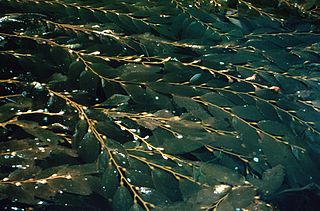
Macrocystis is a monospecific genus of kelp with all species now synonymous with Macrocystis pyrifera. It is commonly known as giant kelp or bladder kelp. This genus contains the largest of all the Phaeophyceae or brown algae. Macrocystis has pneumatocysts at the base of its blades. Sporophytes are perennial and the individual may live for up to three years; stipes/fronds within a whole individual undergo senescence, where each frond may persist for approximately 100 days. The genus is found widely in subtropical, temperate, and sub-Antarctic oceans of the Southern Hemisphere and in the northeast Pacific from Baja California to Sitka, Alaska. Macrocystis is often a major component of temperate kelp forests.

Mastocarpus stellatus, commonly known as carrageenan moss or false Irish moss, is a species in the Rhodophyceae division, a red algae seaweed division, and the Phyllophoracea family. M. stellatus is closely related to Irish Moss. It grows in the intertidal zone. It is most collected in North Atlantic regions such as Ireland and Scotland, together with Irish moss, dried, and sold for cooking and as the basis for a drink reputed to ward off colds and flu. Marine biologists have completed studies on the medicinal reputation of M. stellatus to discover the full potential of its pharmaceutical benefits. Additionally, marine biologists have conducted research on its potential to serve as an alternative to plastic. The application of M. stellatus in these different industries is correlated with the seaweed's adaptations which developed in response to the environmental stressors present around its location on the rocky intertidal.
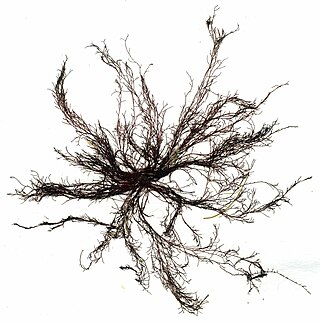
Polysiphonia is a genus of filamentous red algae with about 19 species on the coasts of the British Isles and about 200 species worldwide, including Crete in Greece, Antarctica and Greenland. Its members are known by a number of common names. It is in the order Ceramiales and family Rhodomelaceae.
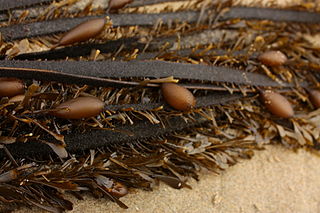
Egregia menziesii is a species of kelp known commonly as feather boa kelp. It is the only species in the monotypic genus Egregia. It is native to the coastline of western North America from Alaska to Baja California, where it is a common kelp of the intertidal zone.

Saccharina latissima is a brown alga, of the family Laminariaceae. It is known by the common names sugar kelp, sea belt, and Devil's apron, and is one of the species known to Japanese cuisine as kombu. It is found in the north Atlantic Ocean, Arctic Ocean and north Pacific Ocean. It is common along the coast of Northern Europe as far south as Galicia Spain, the coast of North America north of Massachusetts and central California, and the coast of Asia south to Korea and Japan.

Codium fragile, known commonly as green sea fingers, dead man's fingers, felty fingers, forked felt-alga, stag seaweed, sponge seaweed, green sponge, green fleece, sea staghorn, and oyster thief, is a species of seaweed in the family Codiaceae. It originates in the Pacific Ocean near Japan and has become an invasive species on the coasts of the Northern Atlantic Ocean.
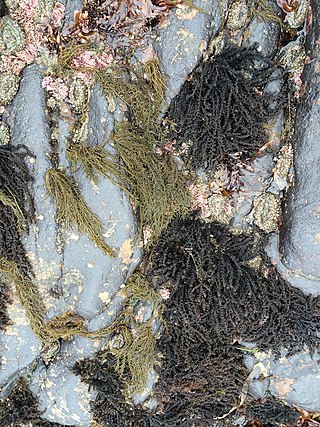
Neorhodomela larix, commonly known as black pine, is a species of red algae native to coastal areas of the North Pacific, from Mexico to the Bering Sea to Japan. It forms dense mats on semi-exposed rocks in intertidal areas. The thallus is dark brown to black in color with whorled branches resembling a bottlebrush.
Lobophora variegata is a species of small thalloid brown alga which grows intertidally or in shallow water in tropical and warm temperate seas. It has three basic forms, being sometimes ruffled, sometimes reclining and sometimes encrusting, and each form is typically found in a different habitat. This seaweed occurs worldwide. It is the type species of the genus Lobophora, the type locality being the Antilles in the West Indies.
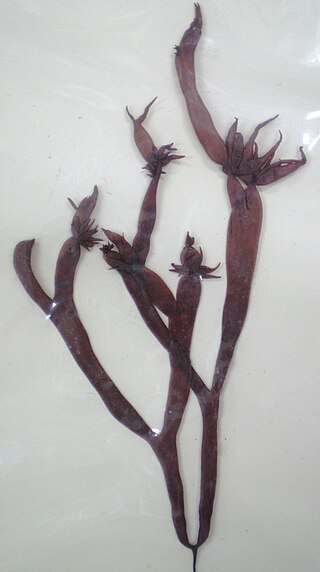
Gloiopeltis furcata, commonly known as glueweed, jelly moss and fukuro-funori (Japan), is a marine alga that is widely distributed in the North Pacific Ocean, along the shorelines of China, Taiwan, Korea, Japan, and the Pacific shores of Russia; and from the Aleutian Islands south to Baja California. G. furcata has long been utilized as a food source in Asia, where it is also used as a sizing material in silk and other textiles. G. furcata is also a raw material for textile binders. Studies show that extracts of G. furcata inhibit the growth of several human cancer cell lines, and can significantly lower blood glucose levels.

Bonnemaisonia hamifera is a species of red alga in the family Bonnemaisoniaceae. Originally from the Pacific Ocean, it has been introduced into the northeastern Atlantic Ocean, where it is considered invasive on European coasts. It exists in two phases which, at one time, were thought to be different species; a medium-sized feathery form attached to other seaweeds, and a small tufted form known as Trailliella.
Polysiphonia brodiei (Dillwyn) Sprengel, now generally spelled "brodiaei", as it is named after James Brodie is a species of red algae in the Rhodophyta. It grows in tufts up to 36 cm long.

Mastocarpus papillatus, sometimes called Turkish washcloth, black tar spot, or grapestone is a species of red algae in the family Phyllophoraceae. It is sometimes confused with the distantly related Turkish towel which is of a similar texture but larger. The specific epithet papillatus is due to the nipple-like projections on the female gametophyte which can give the texture of a terrycloth washcloth found at a Turkish bath.

Chondracanthus exasperatus, commonly called Turkish towel, is a species of seaweed in the family Gigartinaceae. The specific epithet exasperatus refers to the bumpy texture of the blades. This texture also leads to the common name which evokes the luxurious feel of a towel from a Turkish bath. The rough, papillae-strewn blade surface even makes it difficult to measure the temperature using infrared thermometers.

Dictyota binghamiae, commonly known as mermaid's glove, is a species of brown algae found in the eastern Pacific Ocean from British Columbia to Baja California. This species was named in honor of phycologist Caroline Bingham.
Saccharina dentigera is a species of brown algae, in the family Laminariaceae. It is native to shallow water in the northeastern Pacific Ocean from the Gulf of Alaska to Baja California.















